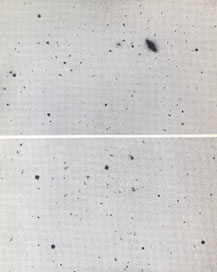


Thus the familiar interpretation of red-shifts as velocity-shifts leads to strange and dubious conclusions; while the unknown, alternative interpretation leads to conclusions that seem plausible and even familiar. Theories may be revised, new information may alter the complexion of things, but meanwhile we face a rather serious dilemma. Some there are who stoutly maintain that the earth may well be older than the expansion of the universe. Others suggest that in those crowded, jostling yesterdays, the rhythm of events was faster than the rhythm of the spacious universe today; evolution then proceeded apace, and, into the faint surviving traces, we now misread the evidence of a great antiquity. Our knowledge is too meagre to estimate the value of such speculations, but they sound like special pleading, liked forced solutions of the difficulty. The fundamental question is the interpretation of red-shifts.
 |
PLATE VI. REMOTE CLUSTERS
The two clusters reproduced in the plate are extremely remote and,
consequently, rather inconspicuous. Their interest lies in the fact that
they bracket the present range of the spectrograph.
|